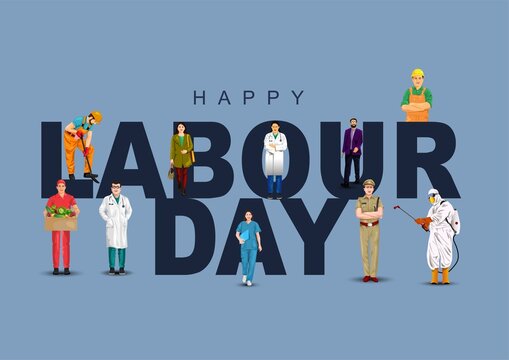May Day, also known as International Workers' Day, is observed globally, including in India, on the 1st of May. As is customary in many nations, on this day, public and government institutions, along with schools and colleges, shut their doors.
The day has historical roots dating back to the infamous 1886 Haymarket affair in the United States. However, it only gained significant recognition in India starting in 1923. Additionally, May Day holds a cultural value in Europe as it heralds the onset of spring—a time associated with fertility and rejuvenation.
- Blogs
- General Knowledge
- Celebrating May Day Unity & Rights 662b3d70bdccdd0001d2d53f
Celebrating May Day: Unity and Rights
General Knowledge • 26 Apr, 2024 • 6,080 Views • ⭐ 2.0
Written by Shivani Chourasia

Date: 1 May 2024
Day: Wednesday
GENERAL KNOWLEDGE QUIZ • 10 QUESTIONS • 2 MINS
We've got a General Knowledge quiz for you!
TAP TO PLAY

States: Most Indian states
May Day: A Brief

May ushers in a fresh season, transitioning from the chill of winter to warmer weather, rejuvenating the landscape with vibrant life. This seasonal change is symbolic of new beginnings and hope, as we observe the natural world around us come alive.
May Day serves as a celebration of unity and solidarity. Individuals from diverse ethnic and cultural backgrounds unite to mark the advent of spring through various customs, which include dancing, singing, and the sharing of flowers and baskets. These activities foster community bonds and shared joy.
Furthermore, May 1st also marks International Workers' Day, commemorating a pivotal moment in labour history. In 1886, a nationwide strike was organized by workers in the United States demanding a standard eight-hour workday. The rally at Chicago’s Haymarket Square escalated into a violent confrontation, resulting in the loss of several workers' lives. In their memory, the International Socialist Conference designated May 1st as a day to honour the labour movement's struggles and triumphs globally.
In essence, May Day is a period of festivity, community, and introspection. It presents an opportunity to both revel in the beauty of nature and the strength of communal ties and to reflect on the continuous fight for social equity and labour rights.
Understanding May Day

May 1st is recognized as May Day in most countries around the world. However, in the United Kingdom and Ireland, the associated public holiday occurs on the first Monday of May, rather than directly on May 1st. Initially endorsed by the Soviet Union in the twentieth century, this day is also referred to as International Solidarity of Workers Day in various Communist states. During the era of the Cold War, celebrations in these communist nations typically showcased large military parades that featured advanced armaments and mass demonstrations of public support for the government.
Interestingly, despite May Day's origins, the United States celebrates Labor Day on the first Monday in September instead. It is speculated that this change was made to dissociate from the memories of the 1886 riots. Additionally, there was governmental reluctance to align with May Day labour celebrations because they were prominently recognized and celebrated by communists and socialists as their principal holiday. Similarly, countries like Canada, Australia, New Zealand, and the Netherlands observe Labor Day on varying dates, which reflects the unique origins and developments of the holiday in each country.
An Overview of May Day's History

The chronology of May Day is marked by key events that have shaped labour rights and worker protests over the years.
In 1886, this date was designated International Workers' Day, now a global celebration honouring labour movements.
By 1894, the United States officially recognized Labour Day as a national holiday, celebrating the efforts and achievements of workers.
However, in 2014, Turkey made attempts to prohibit labour rallies on May Day following violent episodes during earlier protests and riots.
In 2015, despite governmental restrictions against marching to Istanbul's Taksim Square, demonstrators still gathered to observe May Day, leading to violent encounters with law enforcement.
Other Notable May Holidays

- Buddha Purnima
- Guru Rabindranath Jayanti
- Maharshi Parshuram Jayanti
- Birthday of Kazi Nazrul Islam
- Maharashtra Day
- Basava Jayanti
May Day's Impact in India In India, May Day is a commemoration of workers' contributions and sacrifices for societal progress. The roots of this observance go back to when American workers protested against harsh labour laws, violations of workers' rights, poor working conditions, and extended work hours. The essence of May Day is intertwined with the labour struggles and empowerment that emerged in the late 19th century.
It was during one such protest that police fired upon and killed at least two striking workers who were advocating for an eight-hour workday instead of the exhausting sixteen-hour shifts. The tragic event spurred further protests, culminating in the U.S. recognizing the eight-hour workday in 1916.
In India, May Day began to be officially observed on May 1, 1923, initiated by the Labour Kisan Party of Hindustan under the leadership of Comrade Singaravelar, who also pushed for a resolution to declare it a national holiday. Since then, May Day has been celebrated annually.
Typically, the day features speeches from union leaders and various cultural activities, with educational institutions and workplaces remaining closed.
Exploring the Origins and Significance of May Day or International Workers' Day
The origins of May Day date back to Chicago, USA, in 1886, where a workers' union declared a general strike advocating for an eight-hour workday. This strike escalated into violence, leading to police intervention with shelling and the tragic throwing of bombs into the crowd, resulting in numerous worker fatalities and injuries. This event sparked an international movement, leading to annual marches and protests each May Day in support of workers' rights.
India first observed May Day in 1923 in Chennai, the capital of Tamil Nadu. Today, trade unions across India organize parades and competitions for students to highlight the importance of workplace equality. Politicians deliver speeches emphasizing labour rights, and the International Labour Organisation hosts events and programs to commemorate this vital day.
Global Observance of May Day

Globally, May Day, although not always on May 1st, is typically marked on the first Monday of May each year as a bank holiday. The Soviet Union officially endorsed May Day during the 20th century. In England, traditional festivities include Morris dancing and circling the Maypole. Germany made Labour Day a national holiday in 1933. In India, the day is widely celebrated and known by various names: 'Kamgar Din' in Hindi and Marathi, and 'Uzhaipalar Dhinam' in Tamil.
May Day, also known as Labour Day or International Workers' Day, is a public holiday in most European countries including Sweden, France, Poland, Finland, Norway, Spain, Germany, and Italy. Countries in the Americas like Panama, Cuba, Mexico, Guyana, Peru, Uruguay, Brazil, Argentina, and Chile also honor the day. In Canada, the USA, and Australia, May Day is observed at different times throughout the year.
The essence of May Day is to honour the working class, which historically endured shifts longer than eight hours while receiving inadequate compensation. The day is dedicated to educating workers about their rights, emphasizing that under no circumstances should work exceed eight hours without additional overtime pay. Celebrated worldwide, May Day is both a recognition of the labour force and a traditional spring festival in the northern hemisphere.
Conclusion
As we reflect on the historical and cultural significance of May Day, it's clear that this day transcends borders, uniting workers and communities around the world. It not only celebrates the enduring spirit and contributions of the labour force but also serves as a reminder of the ongoing struggle for fair labour practices and workers' rights. May Day is a testament to the power of unity and the ongoing quest for social justice and equality in the workplace, making it a day of both celebration and reflection for all.
Test your General Knowledge! Visit:
https://4123.play.quizzop.com/general-knowledge-quiz/category
Rate this article
Other articles you may like
Host a ‘Palentine’s Day’: Celebrating Friendship on Valentine’s Day
General Knowledge • 7 Feb, 2024 • 34,485 Views

Valentine's Week 2024 Guide: Dates & Celebrations
General Knowledge • 7 Feb, 2024 • 32,379 Views

Simple Life Hacks for Daily Efficiency
General Knowledge • 12 Jan, 2024 • 52,163 Views

National Youth Day 2024: Honoring Vivekananda
General Knowledge • 12 Jan, 2024 • 64,056 Views

Thе Impact of Social Mеdia on Mеntal Hеalth: Navigating thе Digital Landscapе
General Knowledge • 21 Dec, 2023 • 53,386 Views





